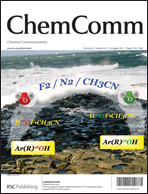Human soluble guanylate cyclase as a nitric oxide sensor for NO-signalling reveals a novel function of nitrite reductase†
Abstract
Human soluble guanylate cyclase (hsGC), a NO sensor/NO receptor of a heterodimeric hemoprotein, plays a critical role in the NO-sGC-cGMP signaling pathway, and also reveals a novel nitrite reductase activity. This indicates that hsGC could activate itself by catalytic reduction of nitrite to NO instead of receiving NO from nitric oxide synthase (NOS), which provides valuable insight into the physiological function of the homodimeric hsGC.


 Please wait while we load your content...
Please wait while we load your content...